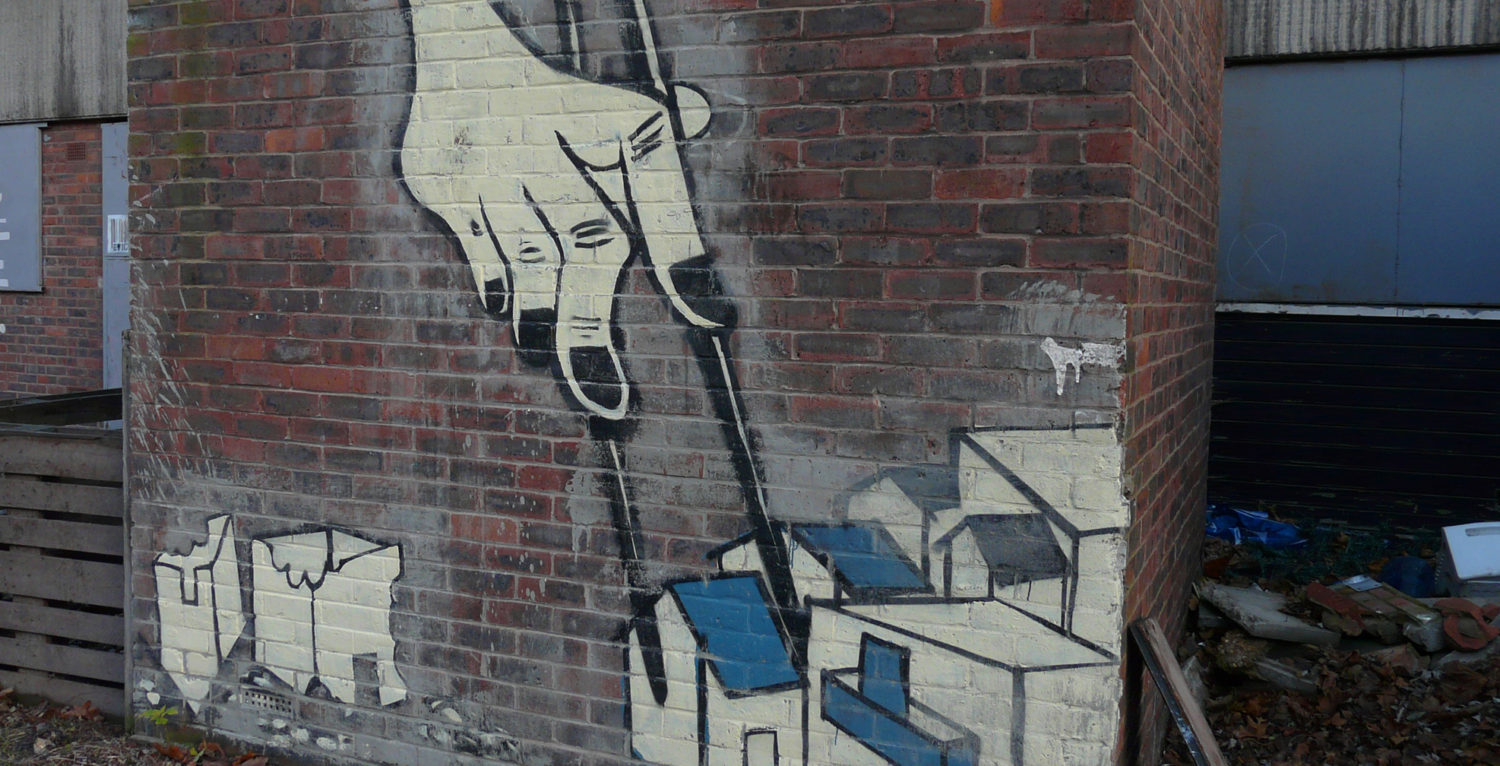The turning tide
The state-led gentrification of council estates has alienated many residents from their – often Labour-run – local authorities, writes Loretta Lees.
New Labour came to power in 1997 with a commitment to the renaissance of British cities and concerned that the social divisions blighting our inner cities shamed us as a nation. On the day after New Labour’s general election victory Tony Blair launched the new government’s regeneration policy from the Aylesbury estate in London, highlighting the estate’s residents as Britain’s ‘poorest’ and the ‘forgotten’, many of whom played ‘no formal role in the economy and were dependent on benefits’. In New Labour’s urban renaissance agenda the council estate played a symbolic and ideological role as a signifier of a spatially concentrated, dysfunctional underclass.
New Labour escalated the dismantling of council housing that the Tories had already begun under Thatcher, drawing heavily on the mixed communities policy that underpinned the US Federal Department of Housing and Urban Development’s HOPE VI programme of poverty deconcentration. This program was being used to demolish (predominantly black) inner city housing projects, like Cabrini Green in Chicago, and replace them with newly built homes for a new social mix of residents. Mixed communities policy was sold to the British public as a moral agenda that would reduce social exclusion and promote the social mobility of the poor by creating mixed tenure communities in which the social capital of the middle classes would trickle down to low income groups. This was a moral underclass perspective sold as a social integrationist one. The New Deal for Communities programme delivered this agenda.
Left liberals were persuaded by the moral tissue of mixed communities policy, after all who could be against the social uplift of the poor? But the emerging evidence base on the failure of mixed communities policy and its actual outcome – displacement of low income communities and gentrification by stealth – was conveniently ignored by the responsible department at the time, the Office of the Deputy Minister, just as it was by its successor, the Department for Communities and Local Government.
Before moving on it is worth reflecting on the ideological content of New Labour’s ideas about urban renaissance, and in particular to think about the ‘place’ they emerged from – gentrifying Islington in inner London. These ideas continue to dominate thinking today, and have had, for the most part, cross-party support.
Blair moved to 1 Richmond Crescent in Barnsbury in 1993. This gentrified house would act as one of the main stage sets of his rise to power, it appeared in the media and in Labour party promotional material. Barnsbury became known as ‘the spiritual home of New Labour’; it became home, like the rest of the N1 postcode and Islington more generally, to a new sociological type – ‘Islington person’. Islington person was the politically correct voice of the chattering classes and a remaking of journalist Nicolas Tomalin’s ‘conspicuous thrifters’, gentrifiers who bought unspoilt houses in unpretentious districts, did them up seeking by the appearance of plain living to create the impression of high thinking and anti-vulgarity. The urbane ideologies and practices of Islington’s gentrifiers and the social networks/ political networking that developed between them (including New Labour politicians, sympathetic journalists, and other professionals), gave birth to New Labour’s ideas on urban renaissance. What emerged was an urban renaissance agenda that was textbook gentrification. The interests and priorities of gentrifiers became a foundational element of the post-industrial city as growth machine in what amounted to a gentrifiers’ charter.
Two specific ideas were at the forefront of New Labour’s urban renaissance policy: social mixing and increased community participation (local democracy). Pioneer gentrification had long been associated with such ideals. Pioneer gentrifiers were part of a left liberal new middle class who actively sought social mixing and social democracy, as seen in the fact that they were champions of the comprehensive school revolution of which Margaret Malden’s Islington Green in Islington was a prototype. As Ken Pring, pioneer Islington gentrifer said: “The present trend towards a rising proportion of the middle classes in the population will continue. This will help create a better social balance in the structure of the community, and the professional expertise of the articulate few will ultimately benefit the underprivileged population”.
Such words virtually echoed New Labour’s urban renaissance rhetoric on social mixing and mixed communities policy. All political ideas are local and it is not without significance that many of them were manufactured in gentrifying Islington. There was, I would argue, a causal relationship between the local experience of gentrification and political reform (from old Labour to New Labour) in Islington and some of the key features of New Labour’s urban renaissance policy.
It was long thought by gentrification scholars that London would never fully gentrify as pockets of council housing stood in the way, protecting low income groups from the ravages of the property market. But as we entered a new millennium it soon became clear that council housing was the final gentrification frontier and under significant threat. New Labour set out to demolish council estates and replace them with new mixed communities.
At first council estate communities were excited at the possibility of their homes being regenerated, attracted by the swanky new apartments and nice new spaces they were told they could move into. But as time went on people began to realise the smoke and mirrors of these schemes. Southwark’s regeneration of the Heygate Estate became symbolic of the false promises and injustices of this ‘renewal’. More than 3,000 council tenants and leaseholders were displaced (their homes and community destroyed), the estate was demolished and its ‘mixed tenure’ replacement, the newly built Elephant Park, marketed off plan in East Asia.
I am currently working on the first in-depth investigation of the impacts of council estate ‘renewal’ in 21st century London. We have now collated an evidence base about the scale of these schemes: since 1997 54,263 units have either been demolished or are slated for demolition on council estates of more than 100 units in London. If we take the London Housing Plan’s average number of households per unit (2.5) a conservative estimate is that 135,658 London council tenants and leaseholders have been or are being displaced. In the case of the Heygate replacement social homes were promised but never materialised and tenants that managed to get rehoused (they had to go on the council’s Homesearch waiting list) did so at some distance from the Heygate area.
What has been (and indeed still is) disturbing is the number of Labour-run councils which – despite this evidence – have continued to promote the gentrification of council estates, from Southwark south of the river to Haringey north of the river. The democratic implications of this are mind boggling – pushing these schemes through against the interests of those they represent. Some are believers in New Labour’s social mixing agenda, some argue there is no alternative at a time of austerity and cuts (even as they make no effort to look for alternatives), some are in bed with developers, indeed many have ended up working for the regeneration industry. Councillors who promote these schemes are on the opposite side of the communities they claim to represent and Londoners are finally waking up to the reality of Labour-run boroughs destroying council estates and gentrifying out the poor.
Public understanding of the complexities of gentrification in London and in other British cities is growing, but it is still nowhere near what it is in New York City where gentrification has been a dirty word for some time now. Tottenham MP David Lammy, who once said that Tottenham could do with a bit of gentrification, has now come out against Haringey’s HDV. Labour’s current leader Jeremy Corbyn (who of course remained MP for Islington North, where I live, during and beyond New Labour’s rise to power) has also recently come out against his own municipal Labour leaders ‘regeneration’ schemes. On the final day of the 2017 Labour party conference he belatedly talked about the ‘forced gentrification and social cleansing’ of council estates, pledging to offer residents the right to a vote in a ballot on future regeneration schemes.
In 2015 both the Conservative minister for housing, Brandon Lewis, and the Labour peer Lord Adonis touted the redevelopment of council estates with market housing as a way to address deprivation and increase housing supply without public funding. Claire Kober did likewise for the Haringey HDV. Two years later and the mood has started to shift and the tide seems now to be turning, costing Kober her job. But this turn has not been quick enough, vocal enough, or strategic enough. A much more concerted effort is needed to stop this process, not just future schemes (as Corbyn’s ballot proposal might do) but also those schemes already slated for redevelopment, such as Cressingham Gardens in Lambeth. The Green party’s London Assembly member Sian Berry has been trying to do this for some time: it is astonishing that the Labour party has only recently raised its head above the parapet. But rejecting these gentrifying schemes is only the first step, alternative strategies for maintaining council estates and building more properly affordable housing need to be developed. There is now a disconnect between voters in general – and council tenants in particular – and the Labour-run councils they see as promoting schemes which essentially push them out.
London is currently in a state of what I call ‘hypergentrification’, many of these council estate gentrifications are in inner London, Labour’s key voting base. As such this has become a real problem for Labour. The question is now whether a real shift in policy away from the gentrification of council estates might rebuild the connection between people and the politicians who represent them. There is hope that this particular gentrification tide has started to turn, but the tide needs to go out and quickly. People’s families, homes, communities and futures are at stake.

